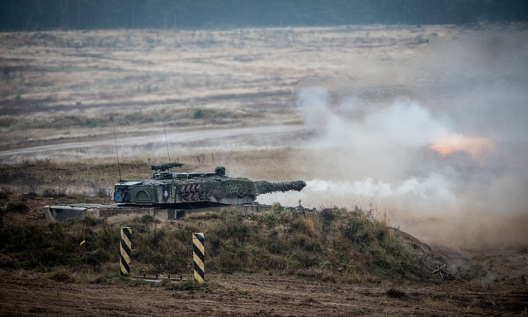 This is the final stage of Steadfast Jazz 2013, NATO’s biggest live-fire exercise since 2006. The manoeuvres in Poland and the Baltic states, which ended on November 8th, involved about 6,000 personnel from NATO countries as well as from Sweden, Finland and Ukraine. About half of them engaged in simulated combat; the rest were part of a command-and-control exercise integrating land, air, maritime and special forces. Latvia was home to the command headquarters; Estonia was victim of an attack by the fictitious Bothnia. . . .
This is the final stage of Steadfast Jazz 2013, NATO’s biggest live-fire exercise since 2006. The manoeuvres in Poland and the Baltic states, which ended on November 8th, involved about 6,000 personnel from NATO countries as well as from Sweden, Finland and Ukraine. About half of them engaged in simulated combat; the rest were part of a command-and-control exercise integrating land, air, maritime and special forces. Latvia was home to the command headquarters; Estonia was victim of an attack by the fictitious Bothnia. . . .
NATO defence spending is falling fast, but Russia’s military budget rose by 26% this year. Nervous border countries also point to the belligerent tone of Kremlin pronouncements, including the threat of preventive attacks on parts of the European missile-defence system that America is deploying. On Good Friday this year Russian warplanes staged a dummy attack on Sweden. Two weeks ago they carried out another one, with Poland and Lithuania targeted too.
Such worries are still, formally, in the background. Anders Fogh Rasmussen, NATO’s secretary-general, said Steadfast Jazz was a “a signal to anyone who might have an intention to attack a NATO ally, but I don’t expect Russia to have any intention to attack NATO allies…so you might say it is a signal ‘to whom it may concern’. . . .”
This month’s exercise and the much larger ones now planned—Trident Juncture in southern Europe in 2015 will be six or seven times bigger—aim to try to preserve Afghan-era co-operation through something called the “connected forces initiative”. Above all, it means that forces from all members (and some partners) have the doctrine and technology to combine on the “networked battlefield”—especially with the Americans, who set many of NATO’s standards.
The beneficiary of all this is the new NATO Response Force (NRF). With a joint headquarters and 13,000 “highly ready and technologically advanced” troops provided on a rotating basis by members, it is seen as the “tip of the spear” for the alliance’s future deployments. This includes everything from acting as the first line of territorial defence to providing disaster relief. The NRF aims to operate either on its own or as a force that buys time before reinforcements arrive. . . .
Furthermore, annual exercises should keep American troops coming to Europe, at a time when the “pivot” to Asia and Pentagon budget cuts mean that their permanent presence on the continent is shrinking. Barely 30,000 American forces are based in Europe today, compared with 213,000 in 1989. Worryingly, America only sent about 300 personnel to Steadfast Jazz (France sent 1,000). When Afghanistan is over, it may show more willing.
Image: A Polish Leopard II tank participating in NATO Exercise Steadfast Jazz (photo: SSgt Ian Houlding/NATO)
